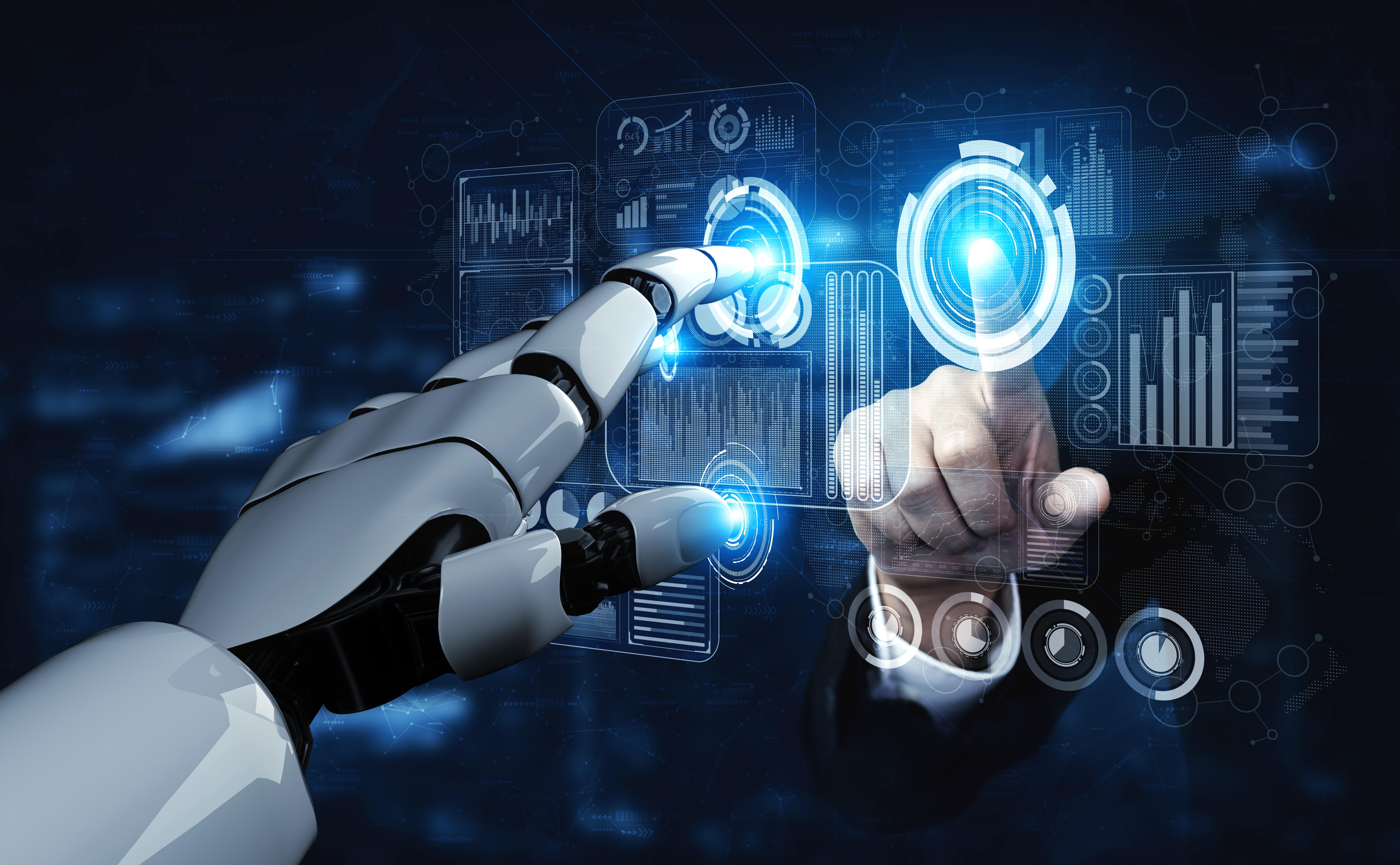It’s easy to feel lost in the AI landscape—especially when automated processes and tools are changing the world as we know it.
But AI is no longer just about automation. It’s also about augmentation, changing how we use technology every day.
These days, AI is pushing boundaries in creativity, decision-making, and problem-solving, making us question its future in 2025.
Let’s take a closer look at key AI breakthroughs and trends, so you can gain a better understanding of how it can help your business and how it’s likely to progress this year.
Evolution of Artificial Intelligence: A Brief Overview
Artificial intelligence has come a long way since the early days of rule-based systems. Back then, computers were only as smart as the rules we gave them.
Early AI was all about hard-coded instructions, a far cry from today’s dynamic learning systems. But as researchers began exploring ways for machines to learn from data, everything changed. The advent of deep learning opened new horizons, allowing computers to understand patterns and make decisions without much human intervention.
This transformation marked the beginning of real AI progress, but all of this didn’t happen in a day; instead, it was a steady evolution.
Early AI (1950s–1980s)
In this time period, artificial intelligence was primarily rule-based, relying on symbolic reasoning, logic, and decision trees. Early pioneers like Alan Turing and John McCarthy laid the theoretical groundwork for AI; however, progress was slow due to hardware limitations and the challenge of programming huge rule sets manually.
Machine Learning (1990s–2000s)
The rise of machine learning marked a shift from rule-based AI to data-driven models. Instead of being specifically programmed for every scenario, AI systems began learning from patterns in data.
Deep Learning & Neural Networks (2010s)
The breakthrough in deep learning, fueled by advances in GPUs and massive datasets, led to AI systems that could process images, speech, and text with human-like accuracy. Convolutional Neural Networks (CNNs) revolutionized computer vision, while models like OpenAI’s GPT and Google’s BERT transformed natural language processing. AI-powered assistants, autonomous vehicles, and real-time translation tools became more common.
Generative AI & Automation (2020s–2025)
Now, AI has evolved beyond analysis and prediction to creative generation. ChatGPT, DALL·E, and Stable Diffusion can generate human-like text, images, and music.
Fun Fact: The idea of machines with human-like intelligence was first imagined in ancient Greek mythology, with stories like Talos, a giant bronze automaton created to protect the island of Crete. (Source: McCarthy, John. “The Dartmouth Conference Proposal 1956.)
What are the Major AI Breakthroughs in 2025?
In 2025, the AI landscape is transforming dramatically. Let’s take a closer look at some of these major advancements.
Generative AI Advancements
Generative AI has come a long way since the early days of models like ChatGPT and DALL·E. In 2025, models are becoming more sophisticated at producing text, images, and fully immersive digital experiences. These next-gen models understand context and emotion better than ever before, making AI feel more human-like.
AI in Healthcare
Healthcare is arguably one of the most exciting frontiers for AI. With the integration of machine learning, doctors and researchers can now detect diseases at earlier stages. They can also tailor treatments to individual patients and speed up drug discovery.
AI in Business Automation
In 2025, hyper-automation—where AI seamlessly integrates with existing business processes—will become the norm. Companies will continue to leverage AI to streamline operations and predict market trends with more accuracy than ever.
AI and Robotics
AI and robotics are transforming industries, including the use of humanoid robots in factories and AI-powered drones for advanced logistics. This isn’t about replacing human labor. Instead, the goal is for machines to handle repetitive tasks while humans focus on strategic and creative efforts.
AI in Cybersecurity
With the power to analyze vast amounts of data in real-time, AI systems can identify anomalies and potential vulnerabilities before they become critical issues. This breakthrough in progress in artificial intelligence will continue to shape cybersecurity processes.
Did you know? Axios found that approximately one in six U.S. workers utilize AI in their daily tasks. Another 25% believe AI could handle at least part of their duties.
What are the Key Trends Shaping the Future of AI?
As we enter a new tech era, several trends will shape the future of AI technology.
AI and Workforce Augmentation
The concept of a “superagency” in the workplace is becoming a reality. Rather than simply replacing human jobs, AI is increasingly seen as a partner that augments human capabilities. By automating mundane tasks, AI frees up time for employees to engage in more meaningful work.
This AI trend also drives team trainings at companies around the globe, as businesses invest in educational programs to help their teams get the most out of AI systems.
Ethical AI & AI Governance
With great power comes great responsibility—and nowhere is this truer than in AI. As artificial intelligence development expands, ethical considerations are more important than ever.
Addressing algorithmic bias, data privacy, and accuracy is crucial for building trust in AI systems. As a result, governments and regulatory agencies are stepping in with policies to ensure responsible AI development and usage.
AI and the Metaverse
The rise of the metaverse is also creating new opportunities for AI. Virtual assistants and immersive AI-driven experiences transform interactions. This intersection of AI and virtual reality is redefining business ventures and contributing to a forward-thinking future.
Sustainable AI & Green Computing
As AI systems become more powerful, their energy demands also rise. To combat this issue, there’s a growing trend toward sustainable AI and green computing. Researchers are developing energy-efficient algorithms and eco-friendly hardware that reduce the carbon footprint of AI tools. This focus on sustainability ensures that the rapid progress in artificial intelligence doesn’t harm our environment.
AI in Education & Skill Development
Education is also getting a major upgrade thanks to AI. Personalized learning platforms, AI tutors, and automated content generation, from lesson plans to quizzes, are changing learning practices. Students can now access tailored educational resources that adapt to their unique learning style. This trend shows one of the best aspects of AI progress: training future generations with vital skills needed in the working world.
What are the Challenges in AI Development & Adoption?
As exciting as AI advancements are, there are still a variety of challenges that businesses need to navigate carefully:
Data Privacy & Security Concerns
One of the major concerns in AI development is ethical data use. Data privacy and security have become critical concerns, with AI systems relying heavily on large amounts of information. Issues such as unauthorized surveillance, data breaches, and misuse of personal information are major discussion topics about AI progress.
Job Disruptions & Workforce Changes
While AI is helpful for improving productivity and shaping innovation, it raises valid concerns about job displacement. As machines take over repetitive tasks, some fear that the human workforce may be left behind.
However, history shows that technological changes often create new jobs even as old ones disappear. The key is to ensure that workers are equipped with the skills needed for emerging roles in the future of AI.
Regulatory & Legal Challenges
Rapid advancements require in-depth legal frameworks. Governments worldwide are struggling with how to regulate AI while still leaving room for innovation. Transparency and accountability within AI systems require a close attention to detail. As policies evolve to keep pace with the fast-moving tech landscape, companies involved with artificial intelligence development must stay compliant to avoid legal penalties.
Technical Limitations
Even as AI technologies push boundaries, they can’t do everything. Technical challenges such as AI hallucinations (where systems generate plausible but incorrect responses), algorithmic biases, and dependence on massive computational power remain major issues. These limitations remind us that while the progress in artificial intelligence is impressive, there is still lots of work to be done.
Caution: AI can reinforce biases in its training data, leading to unfair outcomes. Amazon once scrapped an AI hiring tool after it was found to favor male candidates.
What is the Future of AI?
Peeking into the crystal ball of technology, the future of AI is both exciting and a bit daunting. We’re at the turning point of realizing Artificial General Intelligence (AGI) systems that could potentially match or exceed human intelligence in every way. This isn’t just about making smarter chatbots but fundamentally changing interactions.
The Rise of Artificial General Intelligence (AGI)
AGI represents the next big leap in AI, where machines are not just good at specific tasks but can understand, learn, and apply knowledge across a range of areas. The implications are huge—imagine systems that can think critically and work alongside humans seamlessly. While AGI is still evolving, every aspect of AI progress brings us closer to this reality.
AI-Human Collaboration
One of the most promising aspects of AI technology’s future is the potential for improved human-machine collaboration. Decision-making in industries from finance to healthcare could be transformed by AI systems. This boosts efficiency and innovation, as human intelligence complements AI’s analytical skills.
Solving Global Challenges
AI’s potential extends beyond business and entertainment—it can contribute to solving some of the world’s biggest challenges. From combating climate change and improving energy efficiency to aiding in disease eradication and disaster management, AI is becoming a critical tool in solving global challenges.
Weighing the Risks
Of course, no discussion of AI’s future would be complete without acknowledging its potential risks. Ethical concerns and even existential threats are all part of the conversation. Balancing AI’s benefits with these risks is something that researchers are working to address through responsible AI usage and regulation.
Moving Forward
While breakthroughs in 2025 have brought exciting advancements, from generative AI and healthcare innovations to business automation and cybersecurity improvements, challenges remain. Data privacy, job disruptions, and regulatory issues remind us that the path ahead is complex.
Embracing these changes while staying aware of the risks will be key to getting the most out of AI and ensuring that it benefits everyone.
Interested in exploring how AI can help your business? Schedule a call with one of our experts to discuss in more detail.
FAQs
1. How has progress in artificial intelligence impacted businesses?
The rapid progress in artificial intelligence has revolutionized business operations. Companies now leverage advanced algorithms for everything from decision-making, to predictive analytics and process automation. From improving supply chains to enhancing customer experiences, AI’s integration into business practices has drastically changed industry standards.
2. What are the biggest challenges in the progress of artificial intelligence?
Despite impressive advancements, progress in artificial intelligence still has its obstacles. Key challenges include data privacy and security, algorithmic bias, and ethical and regulatory concerns. Also, high computational demands and technical limitations, such as AI hallucination, are areas of concern. Balancing innovation with responsible usage is critical.
3. What industries benefit the most from the progress in artificial intelligence?
Virtually every industry can benefit from the progress in artificial intelligence, but some industries benefit more than others. Healthcare, for example, benefits from early disease detection, personalized medicine, and rapid drug discovery. Business automation and manufacturing are also experiencing significant improvements, while cybersecurity and education are using AI to improve efficiency and learning.
4. What role does deep learning play in the progress of artificial intelligence?
Deep learning has been a game-changer in artificial intelligence progress by helping systems learn from huge datasets and identify patterns. Its ability to mimic human-like reasoning and adapt to new information serves as the core of modern artificial intelligence development.
5. What are the ethical concerns surrounding the progress in artificial intelligence?
Ethical concerns are top-of-mind discussions about the progress in artificial intelligence. Data privacy, algorithmic decision-making bias, and AI system transparency have raised concerns around the world. Comprehensive governance and ethical guidelines play a role in ensuring these challenges are addressed responsibly.
6. What future advancements can we expect from the progress in artificial intelligence?
Looking ahead, the future of AI is bright. We can expect the evolution of Artificial General Intelligence (AGI), allowing machines to handle more tasks with human-like understanding. Additionally, improved human-AI collaboration, more sustainable AI models, and breakthroughs in healthcare and cybersecurity are on the horizon. Continuous innovation in AI technology will likely lead to smarter, more integrated systems that shape our daily lives.


